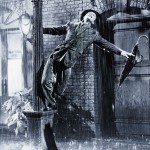Though now often regarded as the greatest film musical ever made, Singin’ in the Rain was only a modest hit when it was first released in 1952. Its stature has grown to near legendary status in the years since. Roger Ebert has even called it “a transcendent experience, and no one who loves movies can afford to miss it.”
As with An American in Paris, producer Arthur Freed conceived of this film as a vehicle for songs of the 1930s. This time, though, it was the songs he himself wrote with Nacio Herb Brown. He hired Broadway writers Betty Comden and Adolph Green to create the story. Since the songs were from the time when silent films were giving way to talking pictures, Comden and Green decided to make the story about that pivotal era in Hollywood, devising three possible openings: a silent movie premiere, a magazine interview, and a star-meets-girl sequence. Comden’s husband Steve suggested that they combine all three, and they did.
Once shooting on An American in Paris was complete, Freed gave the script to Gene Kelly, who enthusiastically signed on to direct and choreograph (with Stanley Donen) and to star as Don Lockwood. Debbie Reynolds (Kathy), Donald O’Connor (Cosmo), and Jean Hagen (Lina) were signed to co-star as the other Hollywood performers caught in the transition from silents to talkies. It was a time that Comden and Green knew well, and they based many supporting roles on real people of that bygone age, including director Roscoe Dexter (on Busby Berkeley) and producer R.F. Simpson (on Freed himself).
In his autobiography, Donen noted that the original scripted ending even included a scene of the premiere for Lina’s newest film, Jungle Princess, in which she “doesn’t say a word — just grunts.” Many production elements from MGM films of the era were also repurposed for this production, including Flesh and the Devil (for Don’s mansion) and Marie Antoinette (for costumes and wigs in The Dueling Cavalier).
The film opened April 11, 1952, to respectable reviews. New York Times critic Bosley Crowther wrote, “All elements in this rainbow program are carefully contrived,” while Washington Post critic Richard L. Coe called it “another fresh and breezy, colorful and funny musical.”
The real cheerleader of the film, though, was New Yorker critic Pauline Kael, who wrote, “This exuberant and malicious satire of Hollywood in the late twenties is perhaps the most enjoyable of movie musicals — just about the best Hollywood musical of all time.” Still, it only received two Oscar nominations, including supporting actress (Hagen), and won neither.
Adaptations include Sam Burlockoff’s graphic version in Eastern Color’s Movie Love #14 (April 1952) and a 1985 stage musical, directed and choreographed by Twyla Tharp. That Broadway production starred Don Correia (Don), Mary D’Arcy (Kathy), Peter Slutsker (Cosmo), and Faye Grant (Lina) and received Tony nominations for book (Comden & Green) and actor (Correia), but won neither.
In 1989, Singin’ in the Rain was among the inaugural class chosen for preservation in the Library of Congress National Film Registry. In the 1998 American Film Institute list of best American movies, it ranked #10; in AFI’s updated 2007 poll, it ranked #5. The 2004 AFI list of top 100 movie songs included three numbers from the film: “Singin’ in the Rain” (#3) (watch here), “Make ’Em Laugh” (#49) (watch here), and “Good Morning” (#72) (watch here). In 2005, the British Film Institute named Singin’ in the Rain one of 50 films to be seen by age 14, and in Sight & Sound’s 2012 list of greatest world films, it ranked #20.
Listen to the soundtrack, then rent or purchase the film through Amazon Prime. TCM regularly broadcasts the film, and it will next on July 19 at noon. For more on the making of the movie, read the 1992 BFI Film Classics book on Singin’ in the Rain by Peter Wollen or Singin’ in the Rain: The Making of an American Masterpiece (2009) by Earl J. Hess and Pratibha A. Dabholkar.
NEXT, look for another Freed Unit classic: The Band Wagon (1953), starring Fred Astaire and Cyd Charisse, with a screenplay by Comden and Green, directed by Vincente Minnelli. The highlight of the score, by Arthur Schwartz and Howard Dietz, is “That’s Entertainment” (watch here).
THEN, explore Gigi (1958), the final great achievement of the Freed Unit, with a screenplay by Alan Jay Lerner, directed by Vincente Minnelli. The film, which stars Leslie Caron in the title role, won all nine Oscars for which it was nominated, including picture and song, “Gigi” (watch here), by Lerner and Frederick Loewe.

